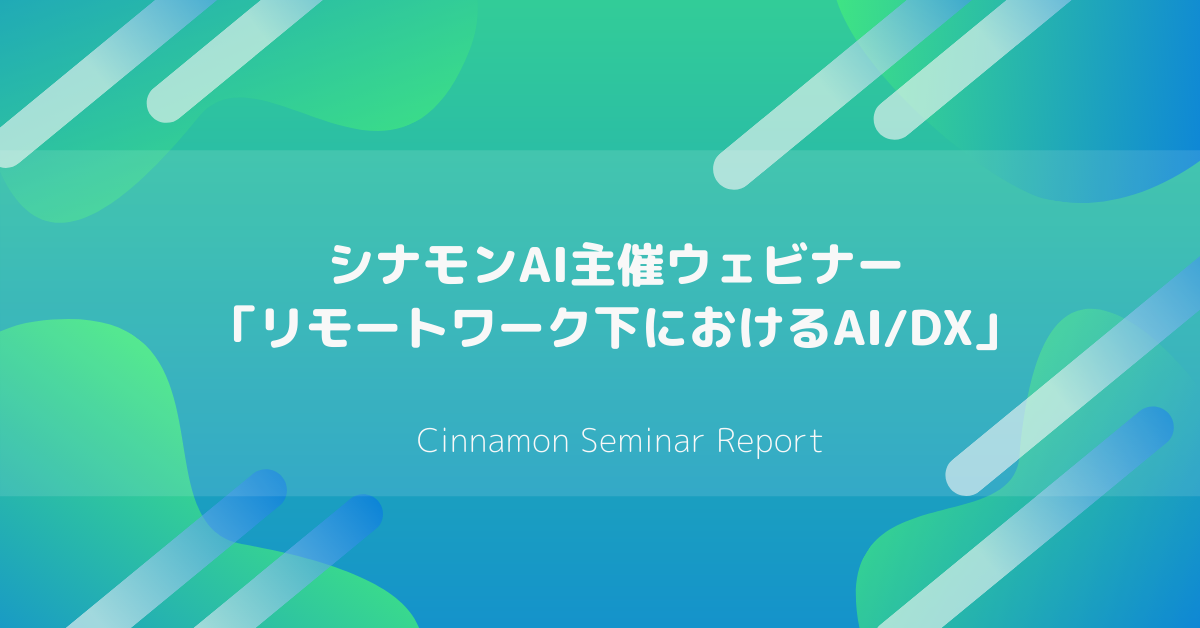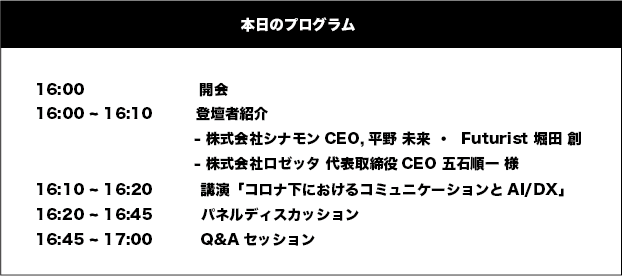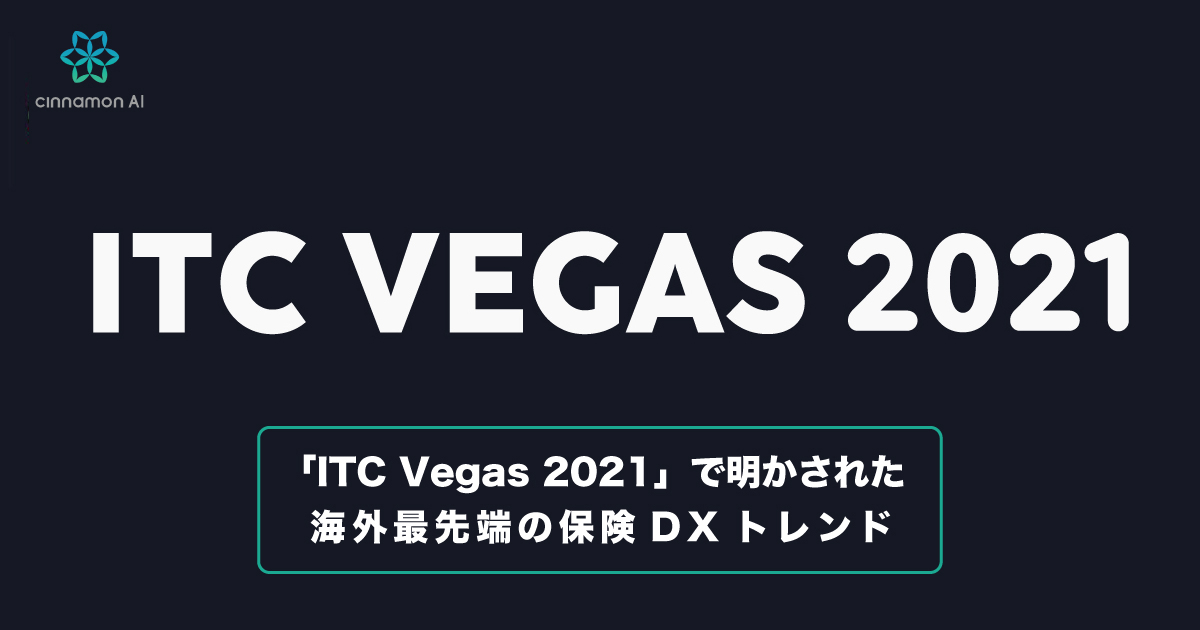
blog cinnamon blog

- event
Webinar report hosted by Cinnamon AI “AI/DX under remote work”

On December 17, 2020, a webinar ``AI/DX under remote work'' sponsored by Cinnamon AI was held.
As remote work spreads during the coronavirus pandemic, internal and external communication is undergoing major changes. What are the specific changes, and what are the benefits and challenges? And what kind of initiatives will be needed? I will report on the seminar, which lasted about 1 hour.
Summary of presentation
■Speakers
Junichi Goishi (Representative Director and CEO, Rosetta Co., Ltd.)
Mirai Hirano (Cinnamon Co., Ltd. President and CEO)
Hajime Hotta (Futurist, Executive Officer, Cinnamon Co., Ltd.)
■Moderator
Yoshiaki Ieda (Vice President, Cinnamon Co., Ltd.)

Speaker introduction
■From Mirai Hirano, President and CEO of Cinnamon Co., Ltd.
Cinnamon Co., Ltd. provides product development and consulting services related to AI (artificial intelligence). Mr. Hirano, who was engaged in research on recommendation engines while in graduate school at the University of Tokyo, started his own company with Mr. Hajime Hotta. He then sold the company and launched Cinnamon.
Hirano points out that currently, business AI is often introduced for the purpose of cost reduction, but it is important to introduce it for the purpose of corporate growth strategy. The company's case study is the solution it provides to Geek Pictures Co., Ltd. that automatically colors animation cell pictures. Although a direct cost reduction effect can be expected, until now much of this coloring work has been outsourced overseas, and by replacing it with AI, it is possible to prevent technology leakage and reduce the number of animators in Japan. He stated that he believes that the use of AI as a growth strategy will lead to the creation of business worth billions of yen by allowing the focus on training. Hirano then proposes a framework called "Double Harvest" to utilize AI as a growth strategy. This is a framework for converting five end values into strategies: improving operational efficiency, reducing risk, strengthening profits, improving UX, and R&D. For example, in the case of an anime production company, the purpose of using AI is to improve operational efficiency, but ultimately it will be possible to adopt a cost leadership strategy.
■From Junichi Goishi, Representative Director of Rosetta Co., Ltd.
Rosetta Co., Ltd., founded in 2004, develops and sells automatic translation and machine translation using AI. Looking back on the early days of the company's founding, Mr. Goishi says:
``What our company developed was automatic translation using data from the Internet.However, ``automatic translation is created with dictionaries and grammar supervised by linguistics experts, so it would be outrageous to use data from the Internet.'' The Internet itself was not generally accepted, and people even said, ``It will disappear eventually. There is no way you can do business on the Internet.''
Mr. Goishi says that his previous experience as the president of an English conversation school led him to want to free Japan from the curse of linguistic handicaps, which led to his current business.
"Why do only Japanese people have to suffer so much? Isn't this an unfounded handicap? I started to think that it wasn't the Japanese people's fault, but that the situation itself was wrong."
Three years ago, the company became able to achieve the same quality as professional document translators for specialized documents such as medical, legal, and financial documents.
Lecture “Communication and AI/DX during the coronavirus pandemic”
Speaker: So Hotta, Executive Officer and Futurist of Cinnamon Co., Ltd.
Mr. Hotta is an engineer who obtained a Ph.D. in AI in 2008. I moved to Southeast Asia in 2012 and am in charge of Cinnamon AI's laboratories in Vietnam and Taiwan, where the company employs over 100 AI researchers. Also, this seminar was attended by participants from Malaysia.
With the spread of remote work accelerating due to the coronavirus pandemic, changes are also occurring in internal communication. For example, in the past, employees could share information about each other's personalities, the situation in other departments, the company's instructions and training background through casual conversations, chats, and lunches in the office, but with the switch to remote work, this has become easier. is becoming difficult.
The key word that Mr. Hotta picked up here was "shared cognition." The background knowledge shared through casual conversations and small talk is like a breath of fresh air. Academic research has shown that shared cognition is an important factor influencing productivity. He points out that shared recognition has decreased due to remote work, and efforts are needed to compensate for it.
In fact, Cinnamon strives to share the company's vision and mission by repeatedly explaining it to the entire company in a top-down manner. Additionally, we promote mutual understanding of backgrounds and motivations among employees by holding numerous 1on1 meetings.
panel discussion
This was followed by a panel discussion with three speakers. Due to the influence of the coronavirus, the way we communicate both internally and externally and how we work has changed significantly. There was a lively exchange of opinions about how things have changed, what they are working on, and what they consider important.
Ieda:Due to the impact of the coronavirus, internal and external communication and work styles have changed significantly. First, what changes do you feel?
Hirano:I feel that my efficiency and productivity have increased since I transitioned to remote work. On the other hand, from a communication perspective, I think there are issues for new employees, such as not matching the faces and names of senior employees and having difficulty getting a feel for the atmosphere within the company.
Mr. Goishi:Since our company's founding, in principle, face-to-face meetings have been prohibited, and all decisions have been made on online bulletin boards or chats. However, I did not work remotely and only went to the office. However, due to the effects of the coronavirus, I started working remotely, which eliminated my commuting time and made my work more efficient. However, after a few months, I noticed that my productivity was dropping. Efficiency and effectiveness are two different things, and even though efficiency has increased, effectiveness has decreased.
Ieda:Remote work improves work efficiency, but it also makes it harder to concentrate because employees have families at home, and employees no longer chat with each other, making it harder to come up with ideas. What have you done to improve internal productivity?
Mr. Goishi:It is true that ideas are born from small talk. With remote work, that has disappeared due to lack of communication. Not only that, but employees' awareness and direction become disorganized, which causes a drop in productivity.
The reason we have prohibited meetings is to prevent only certain people from getting together and making decisions behind closed doors. This is because people who should be present at decision-making meetings are not present, or people who are not involved in decision-making gather and time passes, resulting in inefficiencies. Remote work means all employees are behind closed doors, but you can't see how they're working at all. Inconsistencies occurred, such as instructions not being communicated or chats being overlooked, and I was working without direction.
The ``Agile Software Development Manifesto'' published by software developers in 2001 states that development and marketing should work together in the same place. Engineers naturally dislike irrational things, so I used to wonder why we had to work together, but now I understand that.
Our company has set up an office in a VR (virtual reality) space as a tool to compensate for this. In a VR office, you can communicate just like in a physical office. It's not like online conferencing tools where you shut up and listen while someone speaks. Even if everyone is talking at the same time in a VR office, the voices of those close to you will be heard close, and the voices of those far away will be heard far away. You can also speak freely.
Hirano:At Cinnamon AI, we hold one-on-one meetings quite frequently. Even in a short 15 to 30 minute session, I think the amount of information is overwhelmingly greater than chat. We are also taking measures to ensure that communication outside of work does not go to zero, such as holding online shuffle lunches across departments. At first, it was just a private conversation, but recently I feel like the conversation has shifted from small talk to talking about work, like a conversation in an office.
Ieda:Here's a question from a seminar viewer. Mr. Hirano pointed out that it is difficult to convey the atmosphere when working remotely, but is the shuffle lunch a conscious effort?
Hirano:that's right. In addition to shuffle lunches, some employees come to the office, so we created a system after the coronavirus so that the company will proactively provide assistance in those cases as well.
Mr. Hotta:From the management's perspective, I think there are two things: ``communicating the atmosphere'' and ``detecting the atmosphere.''
It's difficult to convey the mood, so repeat the same message over and over again. The number of repetitions has clearly increased with remote work. You can't create a dynamic atmosphere online, but if you say the same thing over and over again, listeners will understand better. I feel that being able to use recording is also a big advantage. If you record what you say to one employee and say to other employees, ``If you watch this, you'll understand the background,'' and they will watch it. This will increase the number of repetitions and the total amount of messages conveyed.
On the other hand, in terms of gauging the atmosphere, we are increasing the number of one-on-one meetings, especially from the HR team to members. In order to understand the issues that each employee is facing, we carefully organize operations, even if it is only for as short as 15 minutes.
Ieda:This is a question from a viewer to Mr. Goishi. Are there any disadvantages to VR, such as not being able to use a keyboard or whiteboard?
Mr. Goishi:We have a lot. Since the technology is still in its infancy, it is not uncommon for problems to occur. To put it simply, if the speed of the communication line is slow or the connection is poor, the connection will drop midway. On the other hand, the useful thing is that you can post anything, including whiteboards, images, videos, websites, etc.
That's right, the keyboard doesn't work. There is a keyboard in virtual space, but it feels like pressing with your index finger, making it extremely difficult to use. After all, a physical keyboard is more familiar and faster. However, these shortcomings will eventually be overcome.
Ieda:Depending on the type of industry or business, it may not be possible to go online. Are there any changes in management in this respect?
Hirano:I think there are some jobs that cannot be done online, and some jobs that will gradually become possible online, but I think the start is to think about how things should be. As the situation changes rapidly, quick decisions are required.
What we are focusing on is the OODA loop. It stands for Observe, Orient, Decide, and Act, and is a decision-making process developed by the U.S. Air Force. When a pilot is under attack, he cannot rely on his superiors for judgment. You have to make your own decisions. At that time, Orient becomes important. Whether members can make the right decisions depends on whether management communicates the mission.
What we often do is feedforward. Feedback is based on the idea that if there are issues with the current situation, we should do something about them. Feedforward, on the other hand, thinks about what it should be in the future and thinks about what it should do now to make it happen.
Ieda:Isn't there a concern that people with low IT literacy will be left behind? Also, if IT literacy differs depending on the generation, what is important for smooth communication?
Mr. Goishi:It may sound insane, but I don't think it's necessary to manage or keep pace.
I think that the in-house principle of manufacturing everything in-house, which is common among technology companies, is dangerous. As various technologies around the world are rapidly evolving, there is a risk of being left behind.
The same is true for people. The very idea of trying to do something about the employees you currently have is a mistake. There are excellent people in the world. As an employee, you don't have to sign a labor contract or gather at a specific work location. All you have to do is assign the right person to the right job. It is no longer necessary to sign a labor contract and be required to come to work from any time until any time. The concepts of companies and work styles are changing, and I think they should continue to change. At our company, we often have people join us as a side job. It's all remote so there's no problem.
Hotta:Some people in Southeast Asia did not have a computer at home. However, I think that a large number of people are now able to use IT tools more than they imagined.
In fact, the stance that companies only need people who can use IT tools is becoming stronger. If you cannot use IT tools, your labor contract will end. People will learn if they can use IT tools. Therefore, if a company takes such a stance, I think learning will be facilitated. I feel that learning has actually been facilitated and a significant number of people are now able to use IT tools.
Ieda:Although there is an issue of how to support people with low IT literacy, we have found that new ways of working that meet the demands of the times are becoming established. Thank you for participating in the seminar.
★Regularly in Cinnamon AIHolding a seminarDoing.
Recommended articles
-
 event
event -
 event
eventOverseas cutting-edge insurance DX trend web revealed at “ITC Vegas 2021”…
Overseas cutting-edge insurance DX trend webinar revealed at “ITC Vegas 2021”…
-
 event
event[5 days only] Double Harvest Summit, archive distribution public page
[5 days only] Double Harvest Summit, archive distribution public page
